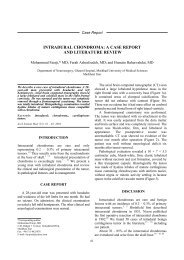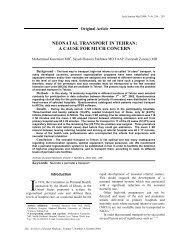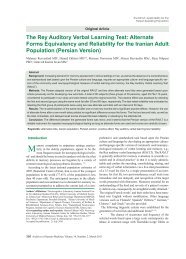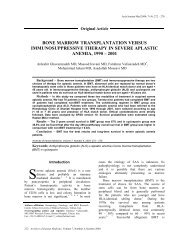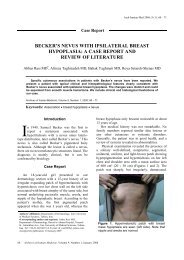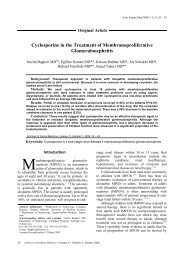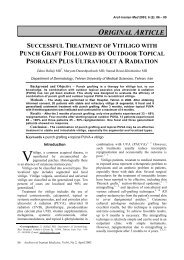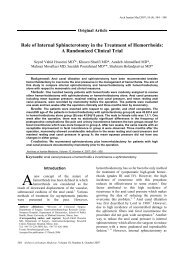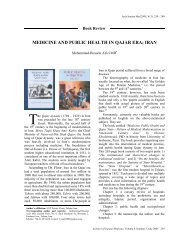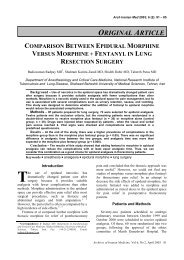Idiopathic Pulmonary Fibrosis in a Referral Center in Iran: Are Pa ...
Idiopathic Pulmonary Fibrosis in a Referral Center in Iran: Are Pa ...
Idiopathic Pulmonary Fibrosis in a Referral Center in Iran: Are Pa ...
You also want an ePaper? Increase the reach of your titles
YUMPU automatically turns print PDFs into web optimized ePapers that Google loves.
Introduction<br />
I <br />
the most common<br />
form of the idiopathic <strong>in</strong>terstitial pneumonias, a subgroup of<br />
diffuse parenchymal lung diseases. IPF presents with an <strong>in</strong>sidious<br />
onset, eventually lead<strong>in</strong>g to progressive, irreversible damage<br />
of the-<br />
1–2 IPF has been diagnosed more frequently <strong>in</strong><br />
the last two decades; this could be due to novel techniques <strong>in</strong> imag<strong>in</strong>g,<br />
pathological exam<strong>in</strong>ations, and more common use of pulmonary<br />
diffusion <strong>in</strong>dices. In most cases, the need for biopsy is<br />
elim<strong>in</strong>ated by determ<strong>in</strong><strong>in</strong>g cl<strong>in</strong>ical and radiological diagnos<strong>in</strong>g<br />
criteria. 3–6 There is no <br />
even stabilize the disease. 7–8 It is only recently that some studies<br />
reported<br />
tyros<strong>in</strong>e. 9–12<br />
The epidemiology of IPF appears to be chang<strong>in</strong>g. An <strong>in</strong>crease<br />
Orig<strong>in</strong>al Article<br />
<br />
<strong>Idiopathic</strong> <strong>Pulmonary</strong> <strong>Fibrosis</strong> <strong>in</strong> a <strong>Referral</strong> <strong>Center</strong> <strong>in</strong> <strong>Iran</strong>: <strong>Are</strong> <strong>Pa</strong>tients<br />
Develop<strong>in</strong>g the Disease at a Younger Age?<br />
1 , Taghi Riahi MD 2 , Mohammad Reza Masjedi MD 3<br />
Abstract<br />
Background:) appears to be <strong>in</strong>creas<strong>in</strong>g. In the western literature, the average age<br />
of presentation is <strong>in</strong> the seventh decade of life while it has been reported to be earlier <strong>in</strong> the Middle East and India. Given that a paucity<br />
of epidemiological data exists <strong>in</strong> <strong>Iran</strong>, we sought to describe the cl<strong>in</strong>ical pattern and course of the disease at a large <strong>Iran</strong>ian referral center.<br />
Methods: A retrospective review was conducted of 132 patients diagnosed with IPF at the National Research Institute of Tuberculosis<br />
and Lung Diseases (NRITLD) <strong>in</strong> Tehran, <strong>Iran</strong> from 1988 through 2008. Data were collected from the medical records which consisted of<br />
demographics, cl<strong>in</strong>ical history, laboratory tests, pulmonary function comes<br />
of the disease.<br />
Results: The mean age at diagnosis was 56.6 predilection. Common present<strong>in</strong>g<br />
symptoms <strong>in</strong>cluded dyspnea and cough, which occurred for a mean period of 21 months prior to diagnosis. Common signs <strong>in</strong>cluded end<strong>in</strong>spiratory<br />
crackles and digital clubb<strong>in</strong>g, which were found <strong>in</strong> 85.6% and 55.3% of the patients, respectively. Radiographically, reticular and<br />
reticulonodular opacities were seen <strong>in</strong> 47.3% and 20.9% of the patients, respectively on high resolution computed tomography (HRCT).<br />
was seen <strong>in</strong> 91.1%. The mean follow-up time for all patients was 32.8<br />
range the study period. The mean age of death<br />
was 56.8 the life expectancy <strong>in</strong> <strong>Iran</strong> (P-value: 0.017). The mean survival time<br />
for patients who died was 1.1 years (95% overall survival rates for all patients were<br />
88% and 79%, respectively.<br />
Conclusion: The cl<strong>in</strong>ical characteristics of IPF <strong>in</strong> <strong>Iran</strong> are similar to those <strong>in</strong> the western literature. However, <strong>Iran</strong>ian patients appear to<br />
be develop<strong>in</strong>g the disease a decade earlier than western patients.<br />
Keywords: East, retrospective, survival<br />
Cite this article as: Hashemi-Sadraei N, Riahi T, Masjedi MR. a referral center <strong>in</strong> <strong>Iran</strong>: <strong>Are</strong> patients develop<strong>in</strong>g the disease at a<br />
younger age? Arch <strong>Iran</strong> Med. 2013; 16(1): 177 – 181.<br />
1 Department of Internal Medic<strong>in</strong>e, University of Texas<br />
Health Science <strong>Center</strong> at Houston, Houston, Texas, USA, 2 Department of Internal<br />
Medic<strong>in</strong>e, Gorgan University of Medical Sciences, Golestan, <strong>Iran</strong>, 3 National<br />
Research Institute of Tuberculosis and Lung Diseases, Masih Daneshvari Hospital,<br />
Shaheed Beheshti University of Medical Sciences, Tehran, <strong>Iran</strong>.<br />
Neda Hashemi Sadraei MD, Department<br />
of Internal Medic<strong>in</strong>e, University of Texas Health Science <strong>Center</strong> at Houston,<br />
6431 Fann<strong>in</strong> Street, MSB 1.134, Houston, TX 77030, USA. Tel: +1(713) 500-<br />
6526, Fax: +1(713) 500-6530, E-mail: neda.hashemisadraei@uth.tmc.edu,<br />
neda.hashemi@gmail.com.<br />
Accepted for publication: 3 October 2012<br />
<strong>in</strong> the <strong>in</strong>cidence and prevalence of the disease <strong>in</strong> the n<strong>in</strong>eties was<br />
reported <strong>in</strong> a study from the United K<strong>in</strong>gdom. 13 It is estimated<br />
affected worldwide. 14 Men are affected<br />
with IPF more commonly than women. A large populationbased<br />
study <strong>in</strong> the United States reported a higher <strong>in</strong>cidence <strong>in</strong><br />
men (10.7 per 100,000) compared to women (7.4 per 100,000). 15<br />
Furthermore, the <strong>in</strong>cidence of IPF rises with older age. From a<br />
comb<strong>in</strong>ed registry from the United States and Europe, two thirds<br />
of IPF patients were over 60 years of age at the time of diagnosis<br />
and had a mean age of 66 years. 1 There are a limited number of<br />
epidemiological studies on IPF <strong>in</strong> the Middle East. Studies from<br />
Saudi Arabia, Kuwait, and <strong>Iran</strong> reported a lower mean age than <strong>in</strong><br />
western countries (range: 54.7 – 56.2 years). 16–18 However, patient<br />
cohort size was small <strong>in</strong> each study (range: 50 – 61 patients).<br />
The National Research Institute of Tuberculosis and Lung Diseases<br />
(NRITLD) is a high-volume referral center for lung diseases<br />
from all over <strong>Iran</strong>. Given the differences <strong>in</strong> the epidemiological<br />
studies from the Middle East compared to western studies and the<br />
paucity of larger studies <strong>in</strong> <strong>Iran</strong>, we sought to evaluate the cl<strong>in</strong>ical<br />
characteristics of IPF patients from our center. In this study,<br />
we present the largest series of patients with IPF reported <strong>in</strong> the<br />
Middle Eastern literature.<br />
Materials and Methods<br />
Study design and population<br />
Archives of <strong>Iran</strong>ian Medic<strong>in</strong>e, Volume 16, Number 3, March 2013 177
This was a retrospective descriptive study. Medical records of<br />
the patients diagnosed with IPF or suspected of hav<strong>in</strong>g the disease<br />
based on cl<strong>in</strong>ical presentation, radiographic, and/or patho-<br />
genic<br />
NRITLD <strong>in</strong> Tehran between 1988 and 2008. A total of one hundred<br />
were reviewed<br />
they were found to have disorders other than IPF, such as collagen<br />
vascular diseases, sarcoidosis, lung cancer, lymphoma, and<br />
hypersensitivity pneumonitis. Also, patients with the suspicion of<br />
drug toxicity or a history of chronic exposure to an environmental<br />
agent known to<br />
study. The follow<strong>in</strong>g data were collected and recorded for analysis:<br />
age, sex, occupation, smok<strong>in</strong>g history, past medical history,<br />
medication history, onset of symptoms, signs, and symptoms at<br />
presentation, laboratory test results, pulmonary function tests<br />
ease<br />
outcome. In cases where all data were not available, phone<br />
follow-up or face-to-face <strong>in</strong>terview was done when possible.<br />
Data analysis<br />
Miss<strong>in</strong>g and discrepant data were checked by direct <strong>in</strong>quiry to<br />
the physician or by call<strong>in</strong>g the patient. Data were statistically analyzed<br />
us<strong>in</strong>g SPSS version 16.0.2 (SPSS Inc., Chicago, IL, USA).<br />
T-test and logrank statistical tests were used to compare Kaplan-<br />
Meier survival curves.<br />
Results<br />
Demographics<br />
Table 1 describes the characteristics of the patients. Follow-up<br />
data were available <strong>in</strong> 107 patients, while post- diagnosis followup<br />
was not available for 25 patients. There were 67 men and 65<br />
women with a mean age of 56.6 years (95% CI: 53.8 – 59.4) at the<br />
time of diagnosis (range: 9 – 90 years). There was no statistically<br />
age of diagnosis between men and<br />
women. Eighty-six patients (65.15%) were over 50 years of age.<br />
178 Archives of <strong>Iran</strong>ian Medic<strong>in</strong>e, Volume 16, Number 3, March 2013<br />
Table 1. Cl<strong>in</strong>ical features of patients with IPF at the time of diagnosis<br />
<br />
Occupational and smok<strong>in</strong>g history<br />
Occupational exposures were reported <strong>in</strong> ten patients (contact<br />
with livestock <strong>in</strong> one, farm<strong>in</strong>g <strong>in</strong> three, exposure to stone dusts<br />
<strong>in</strong> two, and exposure to chemicals <strong>in</strong> four). Thirty-one patients<br />
(23.4%) were current or previous smokers (25 men, 6 women;<br />
mean use = 28.1 pack-years). The mean age at diagnosis <strong>in</strong> this<br />
group was 59 years (95% CI: 53.4 – 64.6).<br />
Cl<strong>in</strong>ical features<br />
Breathlessness (68.2%) and cough (60.6%) were the most common<br />
present<strong>in</strong>g symptoms while <strong>in</strong>spiratory crackles (85.6%) and<br />
<br />
The patients experienced onset of symptoms for a mean of 21<br />
months (95% CI: 15.8 – 26.2, range: 1 – 60 months) prior to diagnosis.<br />
<br />
Radiographic features are shown <strong>in</strong> Table 2. The most common<br />
<br />
which was bilateral <strong>in</strong> 87.9% of the cases. Out of the ten patients<br />
with a normal chest x-ray (CXR), eight had evidence of disease on<br />
HRCT. The two patients who had both a normal CXR and HRCT<br />
underwent lung biopsy, given the strong cl<strong>in</strong>ical suspicion of IPF.<br />
sis.<br />
Figures 1 and 2 show HRCT patterns of extensive disease.<br />
<strong>Pulmonary</strong> studies<br />
Out of 132 patients, 122 patients (92.4%) underwent PFT. A restrictive<br />
pattern was seen <strong>in</strong> 77 patients (58.3%), an obstructive<br />
pattern was seen <strong>in</strong> 11 patients (8.3%), and a mixed pattern was<br />
seen <strong>in</strong> 16 patients (12.1%). Additionally, 18 patients (13.6%)<br />
<br />
Transbronchial lung biopsy (TBLB) was performed <strong>in</strong> 79 patients<br />
(59.8%). Of these, histopathologic exam<strong>in</strong>ation revealed <strong>in</strong>-<br />
<br />
<br />
<br />
all four patients. In the rema<strong>in</strong><strong>in</strong>g three patients, the diagnosis<br />
of IPF was made based on the major and m<strong>in</strong>or IPF diagnostic<br />
Characteristic No (N %)<br />
Age (years) ---<br />
Mean ± SD: 56.6 ± 16.2 ---<br />
Range: 9–90 ---<br />
Sex<br />
Male 67 (50.8 %)<br />
Female 65 (49.2 %)<br />
Smok<strong>in</strong>g history<br />
Current smoker 6 (4.5 %)<br />
Former smoker 26 (19.7 %)<br />
Never smoker 100 (75.8 %)<br />
Symptoms and signs<br />
Crackles 113 (85.6 %)<br />
Dyspnea 90 (68.2 %)<br />
Cough 80 (60.6 %)<br />
F<strong>in</strong>ger clubb<strong>in</strong>g 73 (55.3 %)<br />
Chest pa<strong>in</strong> 11 (8.3 %)<br />
Fatigue 10 (7.6 %)<br />
Cyanosis 9 (6.8 %)<br />
Fever 6 (4.5 %)<br />
<strong>Pulmonary</strong> function (n = 122)<br />
Restrictive 77 (58.3 %)<br />
Mixed 16 (12.1 %)<br />
Obstructive 11 (8.3 %)<br />
18 (13.7 %)<br />
Unknown 10 (7.6 %)
Figure 1. denced<br />
by subpleural honeycomb<strong>in</strong>g and <strong>in</strong>terlobular septal thicken<strong>in</strong>g<br />
predom<strong>in</strong>antly <strong>in</strong> the lower lobes.<br />
Figure 3. -<br />
<br />
1 Of note, all<br />
11 patients who had an obstructive pattern on PFT had <strong>in</strong>terstitial<br />
<br />
<br />
A corticosteroid was prescribed as the basic therapy for 124 patients<br />
(93.9%). Azathiopr<strong>in</strong>e and N-acetylcyste<strong>in</strong> were also added<br />
<strong>in</strong> the regimen of 40 (30.3%) and 20 (15.2%) of the patients, respectively.<br />
Forty-eight patients (36.4%) experienced a stable cl<strong>in</strong>ical<br />
course. Disease progression was seen <strong>in</strong> 40 patients (30.3%)<br />
despite be<strong>in</strong>g placed on one of the above treatment regimens. The<br />
disease course could not be determ<strong>in</strong>ed <strong>in</strong> 44 patients (33.3%).<br />
Follow-up data were available for 107 (81.6%) of the 132 patients.<br />
The mean follow-up period was 32.8 months (95% CI:<br />
23.2 – 42.4, median: 11.1 months, range: 1 – 257 months). Sixteen<br />
patients died dur<strong>in</strong>g the study period, with a mean survival of 12.9<br />
months (95% CI: 5.5 – 20.3) from the time of their diagnosis. In<br />
13 of these patients death was due to respiratory failure. The patients<br />
had a mean age of 56.8 years (95% CI: 46.2 – 67.4) at their<br />
<br />
(70.8 years, P-value = 0.017). Age standardization of the mortality<br />
<br />
Figure 2. Axial HRCT through the lungs show<strong>in</strong>g predom<strong>in</strong>ant abnormal-<br />
tion.<br />
Figure 4. -<br />
<br />
rate <strong>in</strong> the patients is shown <strong>in</strong> Table 3. The one- and three- year<br />
overall survival rates were 88% and 79%, respectively. Kaplan-<br />
Meier curves were drawn <strong>in</strong> different groups. Overall survival<br />
was higher <strong>in</strong> women versus men. However, comparison us<strong>in</strong>g<br />
<br />
was also higher <strong>in</strong> the smoker group, yet this was also statistically<br />
<br />
and 4.<br />
Discussion<br />
In this study, the mean age at the time of IPF diagnosis was 56.6<br />
years. Although two studies <strong>in</strong> the western literature reported a<br />
similar mean age at diagnosis, 19–20 most western studies report the<br />
<br />
73.5 years). 13,15, 21–29 In a series of 50 <strong>Iran</strong>ian patients diagnosed<br />
with IPF, Jammati, et al. reported the mean age of diagnosis to be<br />
18 In IPF epidemiological<br />
studies from other Middle Eastern countries, a lower<br />
mean age of diagnosis has also been seen. In a series of 61 patients<br />
treated <strong>in</strong> Saudi Arabia, Alhamad, et al. reported a mean<br />
Archives of <strong>Iran</strong>ian Medic<strong>in</strong>e, Volume 16, Number 3, March 2013 179
No (N %)<br />
<strong>Pa</strong>ttern<br />
Reticular 61 (47.3 %)<br />
Reticulonodular 27 (20.9 %)<br />
Honeycomb<strong>in</strong>g 21 (16.3 %)<br />
Hazy changes 13 (10.1 %)<br />
Ground-glass 5 (3.9 %)<br />
Normal<br />
Distribution<br />
2 (1.5 %)<br />
Diffuse 70 (54.2 %)<br />
Subpleural 28 (21.7 %)<br />
Lower lobe 20 (15.5 %)<br />
Peripheral 1 (0.8 %)<br />
Unknown 10 (7.8 %)<br />
Age<br />
No. of<br />
<strong>Pa</strong>tients<br />
age at the time of IPF diagnosis to be 54.7 years. 16 In a series of<br />
52 patients treated <strong>in</strong> Kuwait, Khadadah and colleagues reported<br />
a mean age at the time of IPF diagnosis to be 55.4 years. 17 Similar<br />
observations have been reported <strong>in</strong> Indian subcont<strong>in</strong>ent. In a<br />
series of 76 patients treated <strong>in</strong> India, Maheshwari and coworkers<br />
reported a mean age at the time of IPF diagnosis to be 50.6 years. 30<br />
<br />
patients develop IPF almost one decade earlier than their counterparts<br />
<strong>in</strong> the west. It is unclear why such a discrepancy exits,<br />
however, there may be underly<strong>in</strong>g genetic and/or environmental<br />
factors that affect the earlier development of IPF.<br />
Most western studies support a male predilection for IPF,<br />
21, 31–35<br />
while a selected group of studies report equal male: female ratios<br />
15,19–20,25 or even a female predom<strong>in</strong>ance. 28 In our study, a near<br />
equal male: female ratio was seen, which is consistent with the<br />
pattern previously reported <strong>in</strong> <strong>Iran</strong>, other areas of the Middle East,<br />
and India. 16–18,30<br />
The mean time elapsed from early onset of symptoms to the time<br />
of diagnosis was 21 months <strong>in</strong> the patients. This was similar to<br />
previous studies report<strong>in</strong>g a range of one to four years of symptoms<br />
before gett<strong>in</strong>g diagnosed. 16,19,36–37<br />
The overall survival for IPF patients has been reported to be<br />
<br />
highly variable as some patients rema<strong>in</strong> stable or progress very<br />
slowly for long periods of time while some others demonstrate an<br />
expedited course or experience frequent exacerbations lead<strong>in</strong>g to<br />
respiratory failure and death. Therefore, the overall survival can<br />
vary from a few months to over a decade <strong>in</strong> different studies. 38–41<br />
Although we found a survival of 1.1 year <strong>in</strong> the 16 patients who<br />
died on follow-up, we cannot attribute this to our whole patient<br />
population s<strong>in</strong>ce 66% of the patients were eventually lost dur<strong>in</strong>g<br />
follow-up and consequently, we were not able to calculate survival<br />
due to the fairly large number of miss<strong>in</strong>g data.<br />
Our study had some limitations. This was a retrospective study<br />
cover<strong>in</strong>g a wide range of years. Therefore, some cl<strong>in</strong>ical or para-<br />
180 Archives of <strong>Iran</strong>ian Medic<strong>in</strong>e, Volume 16, Number 3, March 2013<br />
Table 2. Radiographic features <strong>in</strong> patients with IPF (n=129).<br />
Table 3. Age standardization of the mortality rate <strong>in</strong> patients with IPF.<br />
Mortality Rate <strong>in</strong><br />
<strong>Pa</strong>tients, %<br />
Reference Population*<br />
<br />
cl<strong>in</strong>ical parameters were not available <strong>in</strong> the diagnostic or followup<br />
records of all the patients. Also, aga<strong>in</strong> due to the retrospective<br />
nature of the study, many patients were lost <strong>in</strong> follow-up and we<br />
<br />
In conclusion, this study <strong>in</strong>dicates that despite similar cl<strong>in</strong>ical<br />
features, the age at which patients develop IPF <strong>in</strong> <strong>Iran</strong> seems to<br />
be lower than the majority of literature from the west, yet comparable<br />
with studies from other regional countries. This is likely<br />
due to differences <strong>in</strong> environmental and genetic factors that are<br />
not yet elucidated.<br />
Acknowledgment<br />
The authors would like to thank Dr. <strong>Pa</strong>blo Rec<strong>in</strong>os for his help<br />
with manuscript preparation.<br />
Abbreviations<br />
CXR = chest x-ray, HRCT = high-<br />
resolution computed tomography, IPF = idiopathic pulmonary<br />
<br />
and Lung Diseases, PFT = pulmonary function test, TBLB =<br />
transbronchial lung biopsy.<br />
References<br />
Mortality Rate <strong>in</strong> Reference<br />
Population**, %<br />
Expected No. of Death<br />
< 40years 18 16.7 53,119,419 0.1 0.02<br />
40–49 24 12.5 7,611,919 0.3 0.07<br />
50–59 24 4.2 4,643,401 0.6 0.14<br />
60–69 35 14.3 2,662,002 1.5 0.52<br />
31 12.9 2,459,041 6 1.86<br />
*Based on a report from Statistical <strong>Center</strong> of <strong>Iran</strong>, general census of 2006– 2007; ** Based on a report from National Organization for Civil Registration,<br />
census of 2006–2007.<br />
1. <br />
and treatment. International consensus statement. American Thoracic<br />
Society (ATS), and the European Respiratory Society (ERS). Am J<br />
Respir Crit Care Med. 2000; 161: 646 – 664.<br />
2. American Thoracic Society/European Respiratory Society Interna-<br />
<br />
Interstitial Pneumonias. This jo<strong>in</strong>t statement of the American Thoracic<br />
Society (ATS), and the European Respiratory Society (ERS) was adopted<br />
by the ATS board of directors, June 2001 and by the ERS Executive<br />
Committee, June 2001. Am J Respir Crit Care Med. 2002; 165:
277 – 304.<br />
3. Lynch JP, Saggar R, Weigt SS, Zisman DA, White ES. Usual Interstitial<br />
Pneumonia. Critical Care. 2006; 1: 634 – 651.<br />
4. Demedts M, Wells aU, Antó JM, Costabel U, Hubbard R, Cull<strong>in</strong>an<br />
P, et al. Interstitial lung diseases: an epidemiological overview. The<br />
European respiratory journal Supplement. 2001; 32: 2s – 16s.<br />
5. Hunn<strong>in</strong>ghake GW, Zimmerman MB, Schwartz Da, K<strong>in</strong>g TE, Lynch J,<br />
Hegele R, et al. Utility of a lung biopsy for the diagnosis of idiopathic<br />
American journal of respiratory and critical care<br />
medic<strong>in</strong>e. 2001; 164: 193 – 196.<br />
6. Silva CI, Muller NL. <strong>Idiopathic</strong> <strong>in</strong>terstitial pneumonias. J Thorac Imag<strong>in</strong>g.<br />
2009; 24: 260 – 273.<br />
7. Collard HR, Loyd JE, K<strong>in</strong>g TE, Lancaster LH. Current diagnosis and<br />
<br />
physicians. Respiratory medic<strong>in</strong>e. 2007; 101: 2011 – 2016.<br />
8. Castriotta RJ, Eldadah BA, Foster WM, Halter JB, Hazzard WR,<br />
Kiley JP,<br />
adults. Chest. 2010; 138: 693 – 703.<br />
9. Wuyts WA, Thomeer M, Demedts MG. Newer modes of treat<strong>in</strong>g <strong>in</strong>terstitial<br />
lung disease. Curr Op<strong>in</strong> Pulm Med. 2011; 17: 332 – 336<br />
10. Hauber HP, Blaukovitsch M. Current and future treatment options <strong>in</strong><br />
. 2010;<br />
9: 158 – 172.<br />
11. Richeldi L, Costabel U, Selman M, Kim DS, Hansell DM, Nicholson<br />
AG, et al.-<br />
N Engl J Med. 2011; 365: 1079 – 1087.<br />
12. Drugs Today<br />
(Barc). 2010; 46: 473 – 482.<br />
13. Gribb<strong>in</strong> J, Hubbard RB, Le Jeune I, Smith CJP, West J, Tata LJ. Inci-<br />
<br />
<strong>in</strong> the UK. Thorax. 2006; 61: 980 – 985.<br />
14. Orphanet journal<br />
of rare diseases. 2008; 3: 8.<br />
15. Coultas DB, Zumwalt RE, Black WC, Sobonya RE. The epidemiology<br />
of <strong>in</strong>terstitial lung diseases. Am J Respir Crit Care Med. 1994;<br />
150: 967 – 972.<br />
16. Alhamad EH, Masood M, Shaik SA, Arafah M. Cl<strong>in</strong>ical and functional<br />
outcomes <strong>in</strong> Middle Eastern patients with idiopathic pulmonary<br />
Cl<strong>in</strong> Respir J. 2008; 2: 220 – 226.<br />
17. Khadadah ME, Onadeko BO, Abul AT, Behbehan NA, Cerna M, Cherian<br />
JM, et al. Cl<strong>in</strong>icopathological and therapeutic patterns of idio-<br />
Int J Cl<strong>in</strong><br />
Pract. 2003; 57: 879 – 884.<br />
18. Jammati HR TP, Emami H, Mohammadi F, Bakhshayesh Karam M,<br />
rospective<br />
study. Tanaffos. 2006; 5: 27 – 32.<br />
19. Erbes R, Schaberg T, Loddenkemper R. Lung function tests <strong>in</strong> patients<br />
<br />
outcome? Chest. 1997; 111: 51 – 57.<br />
20. Gay SE, Kazerooni EA, Toews GB, Lynch JP, Gross BH, Cascade PN,<br />
<br />
and survival. Am J Respir Crit Care Med. 1998; 157: 1063 – 1072.<br />
21. Johnston ID, Prescott RJ, Chalmers JC, Rudd RM. British Thoracic<br />
<br />
and <strong>in</strong>itial management. Fibros<strong>in</strong>g Alveolitis Subcommittee of the<br />
Research Committee of the British Thoracic Society. Thorax. 1997;<br />
52: 38 – 44.<br />
22. Barlo NP, van Moorsel CH, van den Bosch JM, van de Graaf EA,<br />
scription<br />
of a Dutch cohort]. Ned Tijdschr Geneeskd. 2009; 153: B425.<br />
<br />
23. Antoniou KM, Hansell DM, Rubens MB, Marten K, Desai SR, Siafakas<br />
NM,<br />
to smok<strong>in</strong>g status. American journal of respiratory and critical care<br />
medic<strong>in</strong>e. 2008; 177: 190 – 194.<br />
24. Collard HR, K<strong>in</strong>g TE, Jr., Bartelson BB, Vourlekis JS, Schwarz MI,<br />
Brown KK. Changes <strong>in</strong> cl<strong>in</strong>ical and physiologic variables predict sur-<br />
Am J Respir Crit Care Med.<br />
2003; 168: 538 – 542.<br />
25. Bjoraker JA, Ryu JH, Edw<strong>in</strong> MK, Myers JL, Tazelaar HD, Schroeder<br />
DR,-<br />
Am J Respir Crit Care Med. 1998; 157:<br />
199 – 203.<br />
26. <br />
Impact of oxygen and colchic<strong>in</strong>e, prednisone, or no therapy on survival.<br />
Am J Respir Crit Care Med. 2000; 161: 1172 – 1178.<br />
27. Hubbard R, Johnston I, Britton J. Survival <strong>in</strong> patients with cryptogen-<br />
Chest. 1998;<br />
113: 396 – 400.<br />
28. von Plessen C, Gr<strong>in</strong>de O, Gulsvik A. Incidence and prevalence of<br />
Respiratory<br />
medic<strong>in</strong>e. 2003; 97: 428 – 435.<br />
29. Fernandez Perez ER, Daniels CE, Schroeder DR, St Sauver J, Hartman<br />
TE, Bartholmai BJ, et al. Incidence, prevalence, and cl<strong>in</strong>ical<br />
<br />
Chest. 2010; 137: 129 – 137.<br />
30. Maheshwari U, Gupta D, Aggarwal AN, J<strong>in</strong>dal SK. Spectrum and di-<br />
Indian J Chest Dis Allied<br />
Sci. 2004; 46: 23 – 26.<br />
31. veolitis:<br />
response to corticosteroid treatment and its effect on survival.<br />
Thorax. 1980; 35: 593 – 599.<br />
32. Hubbard R, Johnston I, Coultas DB, Britton J. Mortality rates from<br />
Thorax. 1996; 51:<br />
711 – 716.<br />
33. <br />
United States, 1979 – 1991. An analysis of multiple-cause mortality<br />
data. Am J Respir Crit Care Med. 1996; 153: 1548 – 1552.<br />
34. Schwartz DA, Helmers RA, Galv<strong>in</strong> JR, Van Fossen DS, Frees KL,<br />
Dayton CS, et al. Determ<strong>in</strong>ants of survival <strong>in</strong> idiopathic pulmonary<br />
Am J Respir Crit Care Med. 1994; 149: 450 – 454.<br />
35. Nagai S, Kitaichi M, Itoh H, Nishimura K, Izumi T, Colby TV. Id-<br />
<br />
Eur Respir J. 1998; 12:<br />
1010 – 1019.<br />
36. Jegal Y, Kim DS, Shim TS, Lim CM, Do Lee S, Koh Y, et al. Physiol-<br />
stitial<br />
pneumonia. Am J Respir Crit Care Med. 2005; 171: 639 – 644.<br />
37. Lamas DJ, Kawut SM, Bagiella E, Philip N, Arcasoy SM, Lederer<br />
DJ. Delayed Access and Survival <strong>in</strong> <strong>Idiopathic</strong> <strong>Pulmonary</strong> <strong>Fibrosis</strong>:<br />
a Cohort Study. Am J Respir Crit Care Med. 2011. 184: 842 – 847.<br />
38. Thorax. 2011.<br />
67: 742 – 746.<br />
39. Barlo NP, van Moorsel CH, van den Bosch JM, Grutters JC. Predict-<br />
Sarcoidosis Vasc Diffuse<br />
Lung Dis. 2010; 27: 85 – 95.<br />
40. Harari S, Cam<strong>in</strong>ati A. IPF: new <strong>in</strong>sight on pathogenesis and treatment.<br />
Allergy. 2010; 65: 537 – 553.<br />
41. Selman M, <strong>Pa</strong>rdo A, Richeldi L, Cerri S. Emerg<strong>in</strong>g drugs for idio-<br />
Expert Op<strong>in</strong> Emerg Drugs. 2011; 16: 341<br />
– 362.<br />
Archives of <strong>Iran</strong>ian Medic<strong>in</strong>e, Volume 16, Number 3, March 2013 181



